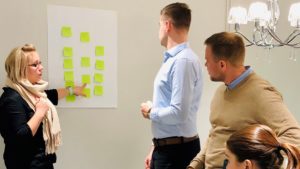If Facility Services Moulded into Standardised Packages: ‘Better Days!’
During 2019–2020, a service design project was carried out at If Group Services. The goal of the project was to form a clear unit of Facility Services’ service offering for all Ifians.
The first steps of the project during the Spring 2019 were filled with terms and concepts that were unfamiliar to many. Service portfolio, catalogue, service design, service design package. The first days felt a bit intimidating. When we started working on answers to simple questions with Post-it notes, things started to click together. The sparring meetings in between the workshops helped to remain focused.
After the service catalogue and team responsibilities had been clarified, the project continued with a customer launch.
– After describing the service portfolio, we launched our service offering in intra. We published everything we had been working on to all Ifians: we brought our new service structure in a visualised form to our customers and partners. We also introduced our updated communication channels’, says Portfolio Manager Santtu Bergström. ‘After publishing the visual portfolio, a completely different stance towards the Facility Services’ service offering was voiced in the house. We received feedback, which stated that now it is easier to comprehend the responsibilities of Facility Services.

Facility Services are a part of support services whose objective is to support business. When actors in the business interface do not even notice the existence of Facility Services, the services function smoothly and generate clear additional value for the business. The work is easy and smooth. Clear service offering has simplified the customers’ errands with the Facility Services. Furthermore, now contacting the services happens through one channel.
– From the perspective of the team, we get things on the table quicker, and the work requests do not get ‘lost’, says Service Manager Anne Ketola. ‘Roles and responsibility mapping has been clarified to match the service portfolio, hand in hand. We know who handles what and who deals with what.’
– One contact point has clarified and simplified running errands with us. Previously, the customer had to know the right person to ask for help – otherwise the work request might have left unnoticed, Santtu continues.
Service design has removed personal tailoring from the Facility Services’ way of working. – We work in a predictive, agreed way. The customer knows what they can get from us and when. We can guarantee that our service is of constant quality. We have changed to a standardised, formalised way of producing services, Santtu says.
– The support operations do not traditionally make a lot of noise about their own projects, even though they have a strong impact on our daily lives. Through service design, we have taken a bigger role in our culture and in implementing our values and vision. With the help of service design, we have been able to describe what Facility Services does in a more mediagenic way. Now people ask us all the time if we had something to say to the entire house, Anne smiles.
By highlighting and reporting on these aspects, the implementation of the service model to the organisation is even stronger. Consequently, the rest of the organisation gains a better understanding of the model. It is not just about describing and packaging the services; Facility Services are strongly connected to employee experiences.
Changes through service experiences
During the project, we also identified several improvement possibilities. The long-term plan has been adapted in an agile way, as new aspects have sprouted from the project, or the updates carried over from the company’s Nordic solutions have impacted our operations.
– The project has brought the bigger picture to the forefront. Now it is easy to discuss challenges and further development since the situation is clear. For example, thanks to the definition of roles and responsibilities, we have been able to construct new job descriptions for recruitment, Anne states.
– We have had numerous changes. We have reviewed the situation through honest service experiences and made decisions on what to keep, what to change and which activities we should give up. We managed to get the tool to support solution creating, Anne describes. ‘We could see the benefit for the customer immediately: we clearly know what is available and where. The email and phone circus in unnecessary. The service comes in automatically when needed. First, we in the team were afraid that the customer service would worsen if we changed from tailored service to a standardised service model. We are still having honest and open discussions about the basis and new operation model every week. That is how it should be: everybody is involved, and their voices are heard. Employee satisfaction surveys portray that the changes have hit the nail on the head, and we are heading in the correct direction.
“We believed that the best way to reach our goal was to cooperate with Justin”
Santtu and Anne do not have to think about the success factors of the project for too long: a great team, seamless cooperation, and a professional partner. Santtu has masterfully kept the structure and material in their hands, while Anne has kept the team committed to the transformation path.
– The organisation of the project has been great. We had a professional service designer included in the team that was able to advance things on a practical level. We had a person in charge of communication, so they knew how to communicate things moving forward. The cooperation has been amazing. We had the same steps in mind, and everybody knew their own responsibilities. This is a good combination, say Anne and Santtu.
Justin had worked together with If already, and people trusted their expertise.
– Our cooperation was flexible and smooth. Justin was able to challenge us in a right way, and they helped us to see the bigger picture from the customer’s perspective. We believed that the best way to reach our goal was to cooperate with Justin. This turned out to be true: we crossed the finish line of the first stage and reached our goal. We have clear and understandable service descriptions. In addition, our internal way of working has also taken a few steps forward. However, the road continues: our next step in this transformation journey is the description of processes. The service portfolio has been described and documented. In the next stage, we need to describe how we manage the bigger picture.
Facts
Service Manager Anne Ketola has been a part of If for close to two years. They oversee the services offered by Facility Services, and they also cooperate with Great Place to Work Finland programme in the field of corporate culture among other activities.
Portfolio Manager Santtu Bergström’s background in IT has also benefitted Facility Services – the intelligent solution interfaces are strongly connected to technology. Santtu has enjoyed their time at If for nine years.
With 3.7 million customers, If is the leading property and casualty insurance provider in the Nordics. If employs 7 900 people. The Facility Services under Group Service make sure that the workdays of Ifians in Finland go smoothly as far as facilities go.
